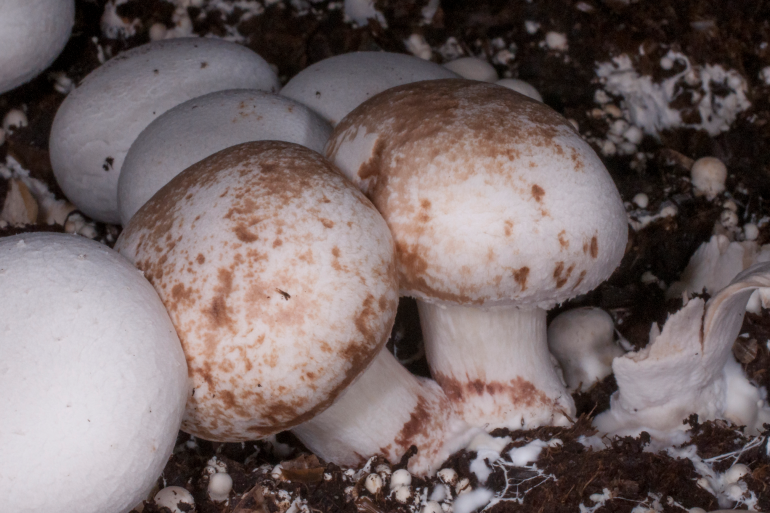Bacterial blotch
Bacteria are present everywhere, all the time – but do not cause bacterial blotch. What does cause bacterial blotch is too many bacteria. A bacterial blotch infection of mushrooms is caused by favourable growth conditions for bacteria.
How can you prevent bacterial blotch? By preventing the conditions in which bacteria can grow rapidly. I will give you some tips in this blog.
Optimal conditions
Humid, warm conditions are ideal for bacterial growth. However, bacterial blotch isn’t immediately visible in these conditions, but they do start to form. The actual blotch is only seen later during or even after harvesting.
Steam or cold water humidification
If you notice signs of bacterial blotch close to the climate unit in the first flush, it’s highly likely that the air humidifier is the cause. Dry cold air is humidified using steam or cold water, but not all the droplets are absorbed by the air. This is especially the case close to the climate unit, where air is blown into the growing room. The droplets not absorbed by the air drop on the surface of the casing soil. This is also where the pinheads form. The pinheads stay moist for too long, causing bacterial blotch. To prevent this problem, wet the floor. This will humidify the growing room. Or increase the moisture content of the inlet air without humidifying it.
Too dry casing soil
You might well think that dry casing soil creates a drier climate. But, that’s not the case.
Casing soil that has dried out absorbs water poorly. After watering, the surface of casing soil stays wet for longer, which causes bacterial blotch. By keeping the casing soil ‘softer’, preventing too much woolly mycelium from growing and applying less CAC material the casing can absorb water more quickly during spraying so there should be fewer problems with bacterial blotch.
Wet for too long
Water is sprayed after the first flush to ensure there is enough moisture in the casing soil for the next flush. Between 6 and 16 l/m2 is applied after the first flush, depending entirely on the conditions in which you grow mushrooms. But, no matter the conditions, the golden rule is that the day after watering, (about 12 – 16 hours later) the surface of the casing soil must be dry again. Check this by placing the palm of your hand on the casing than lifting it again. No droplets of water should attach to your hand. If your hand is wet, the surface has been wet for too long. This means a high risk of bacterial blotch. You can considerably reduce the risk of bacterial blotch by decreasing the RH to 80% after watering, until the surface of the casing is dry.
Mark den Ouden | Mushroom blog | 6 December 2019

